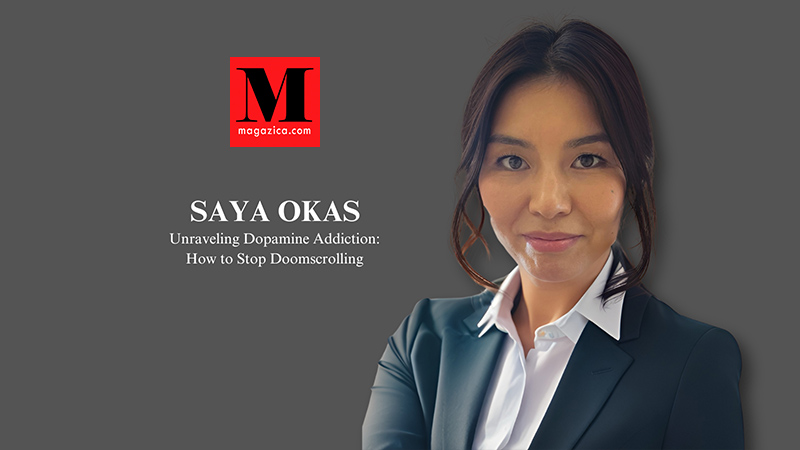Resolve Dopamine Addiction: How to Stop Doomscrolling
- Home
- Resolve Dopamine Addiction: How to Stop Doomscrolling

Resolve Dopamine Addiction: How to Stop Doomscrolling
In a world filled with constant information and stimulation, it’s no surprise that many of us find ourselves falling into the trap of dopamine addiction. Whether it’s endlessly scrolling through social media feeds, watching countless hours of videos online, or constantly refreshing news sites for the latest updates, the need for instant gratification can quickly become a harmful habit.
Dopamine, a neurotransmitter associated with pleasure and reward, serves as the brain’s motivator for essential activities. When we become dopamine-resistant, we start seeking immediate rewards to maintain that dopamine hit. It’s essentially the same cravings we have for sugar; we constantly want something sweet, knowing it’s not healthy but still indulging to get that hit. In a world flooded with stimuli, this reward system can spiral into addictive behaviors.
Whether it’s the allure of social media validation, the thrill of shopping sprees, or the grip of substance abuse, these activities can ignite a relentless cycle of craving and consumption. Dealing with these addictions can be as challenging as dealing with drug or alcohol addiction, as they affect the same part of our brain.
The Dopamine Chase: Understanding Compulsive Behaviors
Our brain’s reward systems are designed to drive us toward behaviors that ensure our survival, such as eating and socializing. However, in our modern environment, these systems can lead to compulsive behaviors and detrimental habits, a phenomenon known as the “dopamine chase.” This chase for quick rewards prevents us from allowing ourselves to feel the “pain” of boredom or other uncomfortable emotions. For instance, the behaviorism approach introduced by B. F. Skinner and the conditioned behavior described by Pavlov teaches us that we continue behaviors that are rewarded. Hence, if dopamine is so accessible, everything becomes conditioned behavior, perpetuating the cycle of “dopamine craving.” Dopamine acts as a stimulus, making normal routines seem boring as they lack positive reinforcement from accessible dopamine.
This addiction began when our lifestyles changed dramatically, and we started relying on immediate gratifications such as drugs, alcohol, fast food, coffee, shopping sprees, and video games or developed busy schedules and became isolated. These habits have reduced our brain’s capacity to wait for rewards. We no longer want to wait for things; we want them right here, right now. Hungry? Just order through Uber Eats without getting off the couch. Bored? Instagram is ready to feed you with endless short content. We’ve trained ourselves so well that we can’t even watch anything longer than a minute or read something lengthy, let alone books.
Recognizing and Addressing Modern Addictions
As an integrative health coach, understanding these concepts is paramount to offering comprehensive support to individuals struggling with addiction and promoting holistic wellness. More people are being diagnosed with ADHD than ever before, largely due to the behaviors mentioned above.
Consider this common scenario: You go to get a drink of water and notice a pile of dirty dishes in the sink. You start washing the dishes and remember that you haven’t added dish soap to your shopping list. While writing the shopping list, you recall a recipe you wanted to try and add the ingredients. Suddenly, you find yourself scrolling Instagram for 15 minutes and realize you haven’t filled up your water bottle. This constant distraction and task-switching sounds like a horror movie script, but it’s the reality for many.
Dopamine sensitivity can significantly impact your well-being and motivation. When we exhaust our dopamine, it starts to affect our motivation and overall well-being. Some people might confuse this feeling with depression as it hits hard. As stated by the Cleveland Clinic (2023): “Dopamine is a neurotransmitter made in your brain. It plays a role as a ‘reward center’ and in many body functions, including memory, movement, motivation, mood, attention, and more. High or low dopamine levels are associated with diseases including Parkinson’s disease, restless legs syndrome, and attention deficit hyperactivity disorder (ADHD).”
You may find yourself in a vicious cycle, wanting to escape but feeling powerless. If you’re fortunate enough to recognize the addiction, you might blame yourself for not being able to stop, only to start the cycle over again.
The Dopamine Dilemma: A Double-Edged Sword
But fear not, for there is hope. Breaking free from the cycle of doomscrolling and regaining control over our dopamine-driven behaviors is not impossible. With a little effort and mindfulness, we can learn to recognize when we are being pulled into the dopamine chase and take steps to break free from its grip.

The first step towards overcoming dopamine addiction is awareness. It’s essential to recognize when we are engaging in compulsive behaviors and understand the underlying reasons behind them. Are we seeking validation from likes and comments on social media? Are we trying to escape feelings of boredom or anxiety? By identifying the triggers that lead us to doomscrolling, we can begin to address the root causes of our addictive behaviors. Understand your trigger (boredom) that leads to the behavior (social media scrolling) and then to a reward (distraction from real emotion that we’re not allowing ourselves to feel). This concept is justified by Skinner’s behaviorism. The ABC model of behavior—antecedent (what happens just before the behavior), behavior, and consequences (what happens right after)—can be useful. People should try to see triggers and antecedents. If they fail to do so, it is important to analyze the consequences of the behavior: how they feel, what was missed, and how they could have used that time.
Holistic Wellness Strategies for Overcoming Dopamine Addiction
Based on the book “The Craving Mind: From Cigarettes to Smartphones to Love – Why We Get Hooked and How We Can Break Bad Habits,” adopting a holistic approach to wellness is essential. This approach addresses the mind, body, and spirit. Here are some strategies to support individuals grappling with dopamine addiction:
Mindfulness Practices: Encourage the incorporation of mindfulness into daily routines through meditation, yoga, or any physical activity, even if it’s just walking or running on the spot. These practices help cultivate awareness and resilience against cravings. When you learn to identify the root of these cravings, it will be easier to control and mitigate them.
Healthy Lifestyle Choices: Advocate for balanced nutrition, regular exercise, and ample sleep to support overall well-being and dopamine regulation. Nutrition plays a crucial role in maintaining balanced neurotransmitter levels, while exercise and sleep help regulate the body’s natural rhythms. Choose whole foods full of nutrition over processed ones; they will give you a steady energy flow throughout the day. Processed foods and sweets spike our glucose, pushing the release of insulin, which then crashes as fast as it has risen, leaving us foggy and drowsy.
Social Support: Foster a nurturing community where individuals can share their struggles and triumphs, offering valuable peer support and camaraderie. Social connections are vital for emotional health and can provide accountability and encouragement. Surround yourself with like-minded people who have similar goals to stay healthy and break free from bad habits.
Structured Routines: Create daily routines that include designated times for work, relaxation, and hobbies. Structure helps manage time effectively and reduces the likelihood of turning to addictive behaviors out of boredom. Use time blocks to leave time for deep focused work, exercise, and mealtime. This will help you manage your time and energy throughout the day.
Mindful Consumption: Be mindful of what you consume, both physically and mentally. Choose nutritious foods, engage in enriching activities, and limit exposure to negative or overstimulating content. Make sure your digital world is also feeding you well; unsubscribe or unfollow from content that gives you anxiety and negative emotions.
Gratitude Practice: Start a daily gratitude journal to focus on positive aspects of life. Gratitude can shift the focus from seeking external rewards to appreciating the present moment. If you’re a spiritual or religious person, prayers also help with calming your nervous system and bringing you into the present moment.
Lifelong Learning: Promote a growth mindset that embraces continuous learning and personal development. Engage individuals in activities that stimulate intellectual curiosity and creativity, such as reading, writing (with pen and paper), or learning new skills. Lifelong learning can keep the brain engaged and reduce the allure of immediate dopamine hits from addictive behaviors.
My personal best is going on a dopamine detox by removing yourself from possible cues that trigger your cravings. Examples of this can be fasting if you’re struggling with sugar or coffee addictions, deleting apps on your phone if it’s social media, etc. By removing the cues, you are less likely to be triggered by the bad behavior you’re trying to break from. Lembke, in her book “Dopamine Nation,” includes research that proves dopamine addiction can be cleaned and restored in 30 days.
It is important to understand what kind of person you want to be and manifest it. For example, if you want to be a healthy person, ask yourself every time you crave something sweet: will this choice help you become healthy? If you want to be successful, will mindless scrolling help you achieve that? What example are you setting for your kids? Be the person your kids, nieces, and nephews would want to emulate.
It’s crucial to remember that breaking free from dopamine addiction is a process that takes time and patience. It’s okay to slip up occasionally and indulge in mindless scrolling, but the key is to learn from these moments and recommit to healthier habits. By cultivating self-awareness, practicing self-care, and prioritizing meaningful connections over digital distractions, we can reclaim our power and break free from the grip of dopamine addiction.
In conclusion, unraveling dopamine addiction and stopping doomscrolling is a journey that requires dedication and perseverance. By taking small steps towards mindfulness and self-awareness, we can learn to navigate the digital world with intention and purpose. Let’s embrace the hope that lies in breaking free from the dopamine chase and reclaiming our lives from the endless cycle of instant gratification. With determination and a hopeful mindset, we can overcome dopamine addiction and create a more balanced and fulfilling life for ourselves. Remember, the path to recovery is not a straight line; it involves setbacks and progress. However, by committing to holistic wellness strategies, fostering supportive communities, and continuously learning and adapting, we can make lasting changes. The rewards of regaining control over our behaviors and fostering deeper connections with ourselves and others are well worth the effort. Let’s take the first step today and start this transformative journey towards a healthier, more mindful life.
Recommended Reading
Brewer, J. (2017). The Craving Mind: From Cigarettes to Smartphones to Love – Why We Get Hooked and How We Can Break Bad Habits. Yale University Press.
Lembke, A. (2021). Dopamine Nation: Finding Balance in the Age of Indulgence. Dutton.
Hari, J. (2022). Stolen Focus: Why You Can’t Pay Attention—and How to Think Deeply Again. Crown.
Newport, C. (2019). Digital minimalism: Choosing a focused life in a noisy world. Portfolio.
Clear, J. (2018). Atomic habits: An easy & proven way to build good habits & break bad ones. Avery.
Alter, A. (2017). Irresistible: The rise of addictive technology and the business of keeping us hooked. Penguin Press.
Moss, M. (2013). Salt sugar fat: How the food giants hooked us. Random House.
McGonigal, K. (2011). The willpower instinct: How self-control works, why it matters, and what you can do to get more of it. Avery.
Bays, J. C. (2009). Mindful eating: A guide to rediscovering a healthy and joyful relationship with food. Shambhala.
- Share
Saya Okas
A results-driven professional with over a decade of experience in education administration. She is a lifelong learner, committed to promoting diversity and inclusivity in education.
